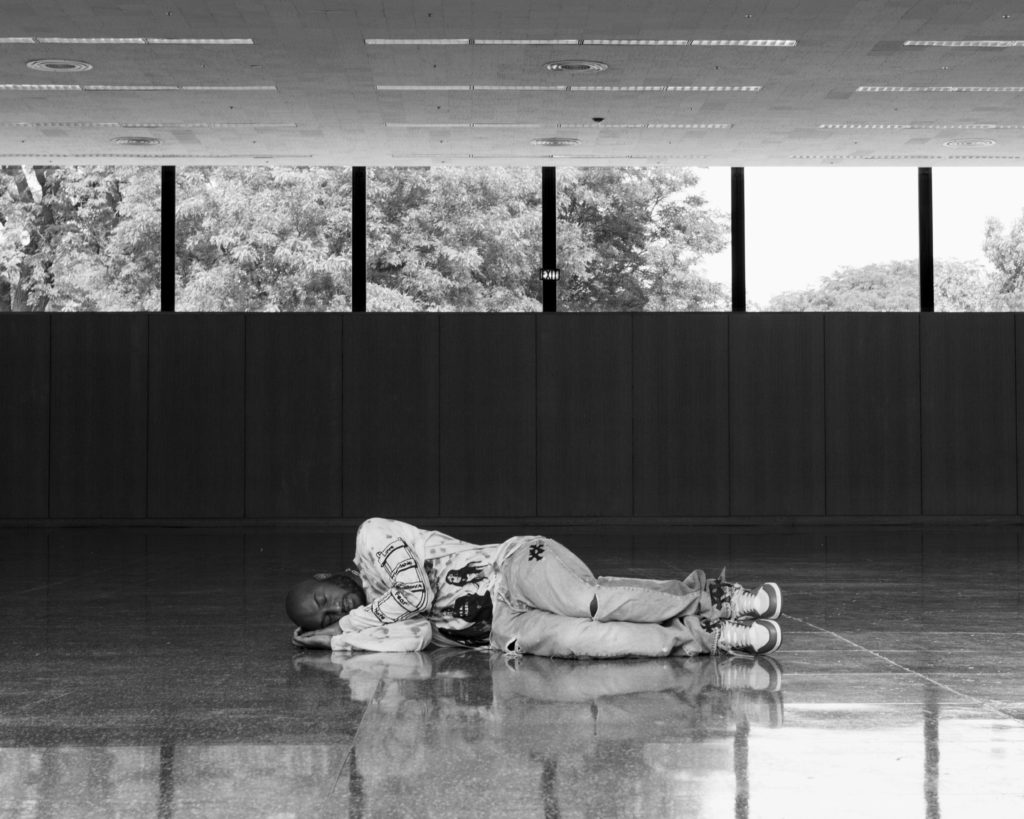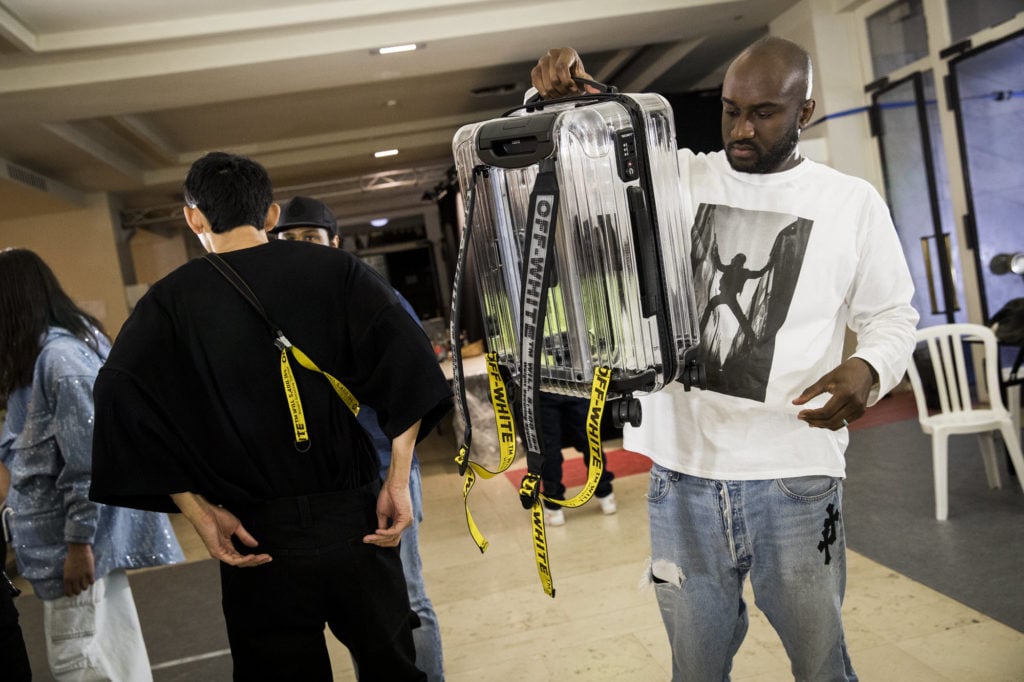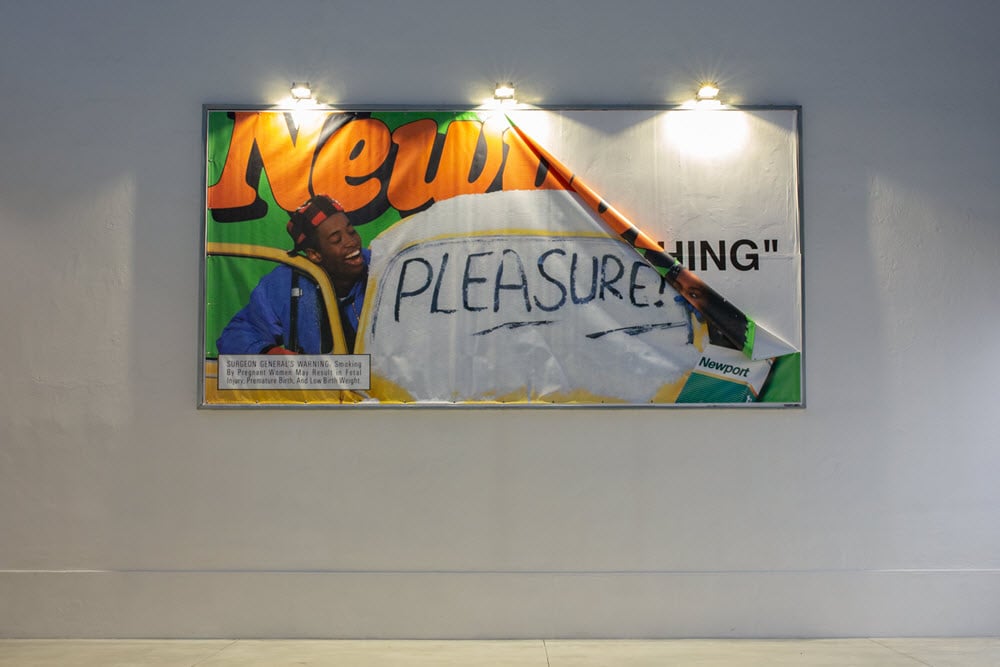Art World
‘A Pair of Socks Can Be Made Into High Fashion Using Intellect’: Virgil Abloh on Why Streetwear Is the Readymade Art of Our Time
We caught up with the art and design polymath ahead of his talk at this year's Design Miami.

We caught up with the art and design polymath ahead of his talk at this year's Design Miami.

Hili Perlson

The Chicago-born polymath Virgil Abloh is the personification of our internet-impacted culture. He has seamlessly moved between genres in a zigzagging line that threads through his training as an engineer, his work in Kanye West’s secretive think tank DONDA, the founding of his own fashion label Off White, and his appointment this past March as the artistic director of Louis Vuitton menswear. It’s exactly this transgressing of traditional boundaries and mixing of high and low, pop and luxury that defines Abloh’s shunning of narrow definitions.
Last week, Abloh presented a new work of art and a lecture at the Spazio Maiocchi as part of a one-day exhibition of artists featured in the latest issue of the Italian art magazine Kaleidoscope, for which Abloh had designed a special-edition cover, T-shirt, and banner. The Milan space was created and founded by Slam Jam and Carhartt WIP for the intention of fusing together the arts and social gatherings; Abloh’s talk centered on his personal manifesto, which asks us to imagine looking back at our current time from the future. What if, so it goes, we realized then that streetwear was the biggest art movement of our time?
Abloh first introduced this thought game during his now well-known 2017 lecture at the Harvard University Graduate School of Design, titled “Insert Complicated Title Here.” The lecture was later published as a book bearing the same title (with Sternberg Press).
The prolific polymath also has a big year ahead, with several shows of his design objects planned across Europe, as well as a major retrospective looking at the last 15 years of his creative output opening at the museum of contemporary art in Chicago on June 10, 2019. He’s also appearing today at Design Miami, where he’ll be joined by artists Arthur Jafa and Torkwase Dyson, fashion designer Grace Wales Bonner, and architect Francis Kéré in a conversation moderated by Hans Ulrich Obrist about human-oriented forms in art.
We caught up with Abloh to speak about what it is about streetwear that could qualify as art

Virgil Abloh at Crown Hall, Chicago. Photo by Richard Anderson.
You’re showing two works in Milan. One is an installation of white flags hanging from the ceiling bearing the statement “Question Everything” with your signature use of quotation marks, as well as a wall-work made of a ripped billboard advertisement. How do these relate to each other and to your treaty on streetwear as an art form?
A part of my practice as an artist has been asking what is the contemporary art of Now. In my community of people making things, and in my generation, there’s a collective way of making objects, representative objects. And that’s why my Harvard lecture was more of a prompt to take that term that’s being used to describe a certain taste of the young population and, instead of thinking of it as a buzzword, perhaps it is linked to the art history that came before it. That’s the larger concept of that.
But the art in Milan is linked to the practice of my work that is rooted in the investigation of advertising, under the premise that before we consume art in a modern society, what we consume via images or projected images is what wires our DNA visually. So, from infancy, the first thing that you see plus the advertising that you’ve been exposed to creates your opinion. The work in Milan, called Stony Island (2018), is a specific study about me, where I’m from in Chicago and projected images of black culture as they relate to agency.
Imbuing a product with meaning or an aura—as advertising aims to do—is often geared toward making it aspirational, something that you must think about in your work as a designer of coveted luxury fashion items. Does this artwork relate to how you work in that field as well?
What was great about the Milan exhibition is that I typically work across all creative disciplines, some days it’s fashion, some days it’s product design, some days it’s art, and with the Milan exhibition being one that was rooted in, quote unquote, “contemporary art,” exactly what I was dissecting was this aspirational aspect. That image, which was a billboard cigarette advertisement that I was used to growing up with in Chicago—a projected image of black culture living life very much, you know, like smiling from ear to ear, the pleasures of life and this particular brand of nicotine, and behind that image that’s peeling off the wall is a white page that says “QUESTION EVERYTHING.” So aspiration to me is the halo that a product has, or a magnetism for a consumer to absorb.
With streetwear, what makes it important is that it made things that are not luxurious aspirational. It’s a practice made up of making things out of readymade objects. So a classic streetwear scenario would be to find a blank T-shirt and print a logo on it that’s not necessarily yours and then give it a twist.
And in today’s society that can become more aspirational than an Italian-made, luxury brand T-shirt of the same sort. Aspiration is the halo which I’m able to dissect and create works of art with.

Designer Virgil Abloh backstage prior to the Off-White menswear spring/summer 2019 show during Paris Fashion Week. Photo by Tristan Fewings/Getty Images.
So streetwear has its conceptual origins in Duchamp and readymades, or to put it in the context of fashion, in the paradigm-shifting work of Martin Margiela. In the show notes for your debut collection at Louis Vuitton menswear, you presented “The Vocabulary According to Virgil Abloh,” where you coined the term Margielaism to refer to, I suspect, the designer’s use of deconstructed readymades. Do you see yourself as a conceptual descendant of Margiela?
Art history precedes that. It’s in our atmosphere, it’s cumulative. Things have a cumulative impact on the rest of the world. And I think Martin Margiela’s investigations in high fashion are about what’s tangible. It might be right in front of us! Everyday objects, a pair of socks, a T-shirt, can all be made into high fashion using intellect. It’s something that is as impactful as Duchamp saying that a urinal is a fountain. And I think that anything made after that can be seen in a different light. Culture itself can be looked at in a certain way.
Was there a specific moment for you growing up when you realized that you needed to “question everything?”
It was in my teenage years, as I started to formulate my hand and eye in art. I started to question things that I regarded as fact, whether that be high fashion or high art or brands. I grew up as a consumer, I consumed things to get my knowledge, but then as I started making things I realized that the things I loved had humble beginnings. Manufactured things come from people like myself. Brands come from people like myself. And that’s when I started my own practice, when I discovered the ability to question everything.
Is that also the origin of your famous three percent design formula—taking something that exists and giving it a three percent twist? Is this your way of exposing, by making slight changes, the central question behind them, the conceptual counterpart to peeling off a billboard and seeing this message in bold print?
It sharpens the knife and my point of view. What am I trying to say in the things that I create? What dots am I trying to connect with a work of art? The work of art that’s showing in Milan is really one of displacement, too. My ability to travel the globe and connect certain dots between cultures and community is exhibited by that work. In Chicago, where that billboard was placed was typically among low-income, high-violence neighborhoods. That fact doesn’t extend or have an impact globally, but for me to be able to place that in Milan and displace it into another community, in my mind, creates a link and a synergy just by the artwork existing there. It could be a message to someone in that low-income, high-violence neighborhood who’d love to travel if their surrounding is considered valuable enough to exist in another country. Or even more intriguing, in a place of high art.

Virgil Abloh, Question Everything (2018). Photo: Ivan Grianti.
Coincidentally, Theaster Gates is also in showing in Milan right now, at the Fondazione Prada, exhibiting a major project that relates to Chicago’s publishing industry and the visual representation of black women in magazines targeted at a black readership. Is there a dialogue or a cross pollination between you?
Theaster in a way to me is like an older brother. The art community in Chicago is rich, there’s something in the water, I firmly believe that. I talk to him often and will see him in Miami. His practice is very important in a landscape of a narrative within art. I think it’s by coincidence that our works are in Italy at the same time, but I don’t think it’s a coincidence that our voice has a place within art at the same time.
How do you see this point in time where old structures may be questioned and voices that didn’t have a stage before are now being heard in the mainstream? It’s been happening in the context of contemporary art for some years now, but your arrival at Louis Vuitton was a watershed moment in the world of high-end fashion.
At a certain point in time, the outside world didn’t have an impact on these sort of sacred places, they were coexisting in polar opposites. And now what we’re finding with the evolution of contemporary art is that there’s something happening with the culture outside that is questioning everything and formulating its own identity: The idea of a millennial challenging the generation that came before, that is a cultural phenomenon. And I think that the art world or fashion world or any sort of canonized place is—or should be—a mirror of the society around it. For me the reason why it’s not a coincidence [to be showing in Milan at the same time as Theaster Gates] is that in art and fashion and literature and any other art form there’s an open space for dialogue with that which wasn’t represented before.
You mention that we’re living in an age informed by irony, but you seem to only associate it with new productivity. Do you see any danger in irony at all? One could also argue that irony got us where we are now politically. Is that something you also consider in your work or is it just a creative tool?
It’s a tool—what the cause and effect is depends on who’s using the tool. A hammer can build homes and it can also destroy somebody; it’s not the tool itself that is conflicted, it’s the person using it. So I think we’re seeing it across different platforms. At the core of it, it’s the impact of social media. It can lead the public in one direction or another, so the link between the danger and irony is not correlated in my mind.
Going back to your other creative tool, I’m trying to think of an equivalent of the three percent formula in the art world. You could argue that applying something similar to his art is what has gotten Richard Prince into legal trouble.
To me it’s kind of funny, you know, like the separation of church and state, the line between art and legality—I don’t think that laws are made with artistic freedom in mind, so there’ll always be a friction. I look at an artwork for what message it’s trying to say, doesn’t matter where it’s from or if it’s legally correct. I do understand that there need to be legal boundaries, but I primarily focus on the message that an artist like Richard Prince is trying to say more than the legal ramifications of what he’s doing.

Virgil Abloh at Farnsworth House, Illinois. Photo by Richard Anderson.
In your lecture at Harvard you said that your use of quotation marks allows you to say two things at the same time. Can you explain that?
For me it’s freedom. These are symbols that are available for everyone, the repetitive use of them can make them mine, but also everyone else’s. But more importantly I love that it allows me to be figurative and literal at once. We’re now in an ironic culture that can communicate itself as being serious and humorous at the same time, so for me it’s evident across my work as a way of speaking and communicating. I can use a keyboard to make a signature without it being myself.
This idea of being figurative and literal at the same time makes me think of the work of John Baldessari and how by pairing short text segments with found imagery he is able to evoke narratives in the viewer’s mind. He once told me in an interview that he would use this concept for as long as it interested him. Otherwise, it’s just making recognizable tokens for the market. Are you concerned that the quotation marks could one day stop being an interesting form of investigation to you and simply become tokens of your signature?
I’m interested in making a vocabulary. I’m interested in the lineage of work, and I’m interested in being consistent between different genres. I love having signatures. My work for me is internal. It’s a dialogue that I’m having about making things over time, and the consistency and refinement of some basic premises. That’s in large part what my show at the Museum of Contemporary Art in Chicago next year is about. Dissecting works I was doing 15 years ago up to now, and how did I arrive at these conclusions.
The show is created in collaboration with by AMO, the design studio led by Rem Koolhaas. Michael Darling [of the MCA] is the show’s curator along with Samir Bental from AMO. Architecture is my first practice and I was intrigued by the work of architects as exhibition makers. I was interested in telling the story of how an architect works in an art space.
And what were you working on 15 years ago?
There’s graphic work, paintings, sculptures, my architectural thesis…
What was it about?
Tall buildings. The future of tall buildings in Chicago. I studied at the Illinois Institute of Technology and I was gauging what would be the future form and function of high-rise buildings.
VIRGIL ABLOH: “FIGURES OF SPEECH” will be on view at the MCA Chicago from June 10–September 22, 2019.